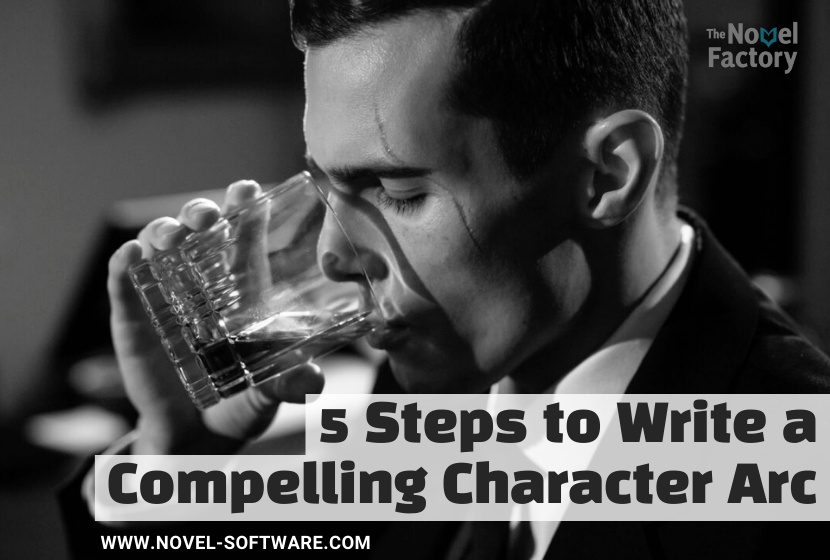
5 Steps to Write a Compelling Character Arc
There are many aspects to writing a good novel: beautiful prose, exciting conflict, compelling themes – but there is probably little more important than the main character arc.
Humans are drawn to stories because they resonate with our own lives and help us learn more about who we are. The best stories teach us how to live better, more fulfilling lives – and we do this by going on a learning journey, alongside a protagonist.
The journey is in essence what a character arc is.
A character ‘arc’ refers to that change that happens, where the first point of the arc starts in one place, and then goes through a transformation, ending in a completely different place.
In this article, we’ll look at the different types of character arcs, and offer a blueprint and a five-step process to help you develop your skills in creating compelling and satisfying character arcs.
Character Arcs versus Plot Arcs

For the purposes of this article, we are going to differentiate between the plot arc and the character arc, although these are sometimes used interchangeably, they are certainly very closely intertwined, and both relate to the character’s actions and emotions.
One useful way to think about it is to think of the plot arc as the ‘visible’ side of the story – the actions that take place. This is related to the character’s external goal, or their ‘want’. Their External Goal is the thing they are clearly, actively pursuing throughout the story.
In contrast, the character arc is much less visible, as it is what is going on inside the character. It is the change in their personality and worldview. They are not actively pursuing it, but it is this internal shift which is the true heart of the story and which will give your readers the most satisfaction.
This is sometimes called the Internal Goal – even though it may not be an active goal for the character at all. It is also sometimes called their ‘need’.
| External Goal aka Want | Internal Goal aka Need |
| The thing outside of them which they are actively pursuing, which drives the story forward. They believe that if they achieve this, they will be happy, but they won’t. | The emotional need which they may not be consciously aware of, or may even be in denial about. But they must fulfil this in order to be truly happy. |
Click here to read more about want versus need.
The 3 Main Types of Character Arcs in Traditional Media
Some writers talk about four types of character arcs, while others go into far more detail and depth, saying there are seven or even twelve different character arcs that can be identified.
In this article, we’ll argue that this universal concept can be distilled into three core types: Positive, Negative, and Flat.
Positive Character Arc (Morally Ascending)

This is by far the most common type of story arc for main characters, especially in standalone novels.
If you only learn about this type of character arc, then you’ll have 90% of the information you need, because 90% of all successful character arcs are of this type.
This is because of what we mentioned above, which is that stories exist primarily as a way of giving us a moral compass, and teaching us how to be better people.
The positive character arc is the one that does that. It takes someone who is flawed and struggling and show their journey to overcome those flaws and become more content and happy in their lives.
This resonates with us on a spiritual level because we all strive to be better people, to be happier, and to make sure those we love are happier.
It’s almost unnecessary to give examples of positive character arcs because you will find them in almost every story you encounter. From Harry Potter to Katniss Everdeen to Elizabeth Bennet to Tarzan, all of these characters go from positions of having something missing in their lives, or having flaws borne of circumstances, to finding their courage, compassion, and true home.
Negative Character Arc (Morally Descending)

While we are drawn to the positive character arc because it makes us feel good, there is also something deliciously tempting about evil.
While we try to be good people, we have a tendency to believe that everyone has a dark side and that there can be something thrilling and exciting about being close to danger.
So, while it’s rare (though not unheard of) to have a main character with a negative character arc, it’s much more common to find a negative character arc when looking at a villain, or supporting character.
The best negative character arcs will be compelling and convincing to the reader – so they feel like they could easily slide down the same slope if they were in that situation.
For example, in season six of Buffy (spoiler alert!), gentle, kind-hearted Willow topples into a morally descending character arc when her lover, Tara is killed. Dark Willow is evil, cruel, and violent – and yet, while we are horrified by her actions, we can’t altogether condemn her, because we feel the depth of her pain, and share her rage at the pointlessness of her loss. We can’t help but feel that her hunger for revenge doesn’t feel entirely unjustified.
Similarly, the writers of Breaking Bad managed to subvert convention by doing the rare thing of giving their protagonist a negative character arc – and to a certain degree getting the viewers to go with him on his journey. The writers have said in interviews that they wanted to see how evil they could make him and people still be rooting for him.
Flat Characters Arcs

This is where the terminology gets a little confusing, so let’s take a moment to clarify what we’re talking about.
A Flat Character Arc (which in itself is a self-contradictory phrase, because an arc is curved, not flat, but let’s not go down that rabbit hole right now) is not the same as a Flat Character.
A Flat Character is essentially a stereotype, whose behaviour never breaks out of one small aspect of their personality. For example the ‘school bully’ or the ‘doting mother’ or the ‘exercise freak’.
The opposite of a Flat Character is a Round Character, which is a character who has nuances, and inner conflicts and is more like a real person who is many different things at different times. For example, the three examples of Flat Characters given above, could all be combined to create a single, Round Character.
Read more about flat characters here.
But we’re not talking about Flat Characters here, we’re talking about Flat Character Arcs. By this, we mean the character ends the story in roughly the same level as they began – as opposed to a Positive Arc where they end up in a better position than they started, and a Negative Character Arc, where they end up in a worse position.
Flat Character Arcs are more commonly found in older, classic stories, whereas modern audiences tend to find ascending (with a sprinkling of descending) arcs more satisfying.
A clear example of this is in how classic characters have evolved for modern audiences. Both Sherlock Holmes and James Bond are iconic, incredibly popular characters. In their original series, they were both pretty flat. While flawed, their flaws didn’t bother them. They didn’t suffer from a lot of soul-searching or feeling like they didn’t belong. They were Kings in their domain.
However, the more modern iterations of both Sherlock Holmes and James Bond have had positive character arcs applied, so that in each of their stories, a clear flaw and pain in their heart is demonstrated at the outset of each episode or series, and throughout the story, they work towards overcoming it – just like any other positive arc.
A Character Arc 7-Point Blueprint
There are many different ways you can write a Character Arc, but below are five key beats that you will hopefully find helpful when it comes to understanding and creating arcs.
1. Character is incomplete

Initially, the character must be demonstrated to be incomplete. They have an unmet emotional need, such as being unable to trust, being unable to love, or lacking courage. I will refer to this as their ‘need’.
Because the character arc will be tied so closely to the plot, it’s important to note that the character will also have an external ‘want’. Something they are trying to achieve, such as a new job, the perfect wife, a trip to Bali or to save the village. In this blueprint, I will refer to this as their Goal.
See the section above: Character Arcs Versus Plot Arcs, for more explanation about Internal and External Goals.
2. Demonstration of the consequences of not addressing this need
It’s very effective to demonstrate to the reader and main character what the consequences will be of ignoring this unmet emotional need.
A perfect example of this is Scrooge, who is given crystal clear visions of how awful the future will be if he continues down his road of selfishness.
Obviously, not all stories are going to be quite this obvious, but the main character may talk to an older miserable character who has the same flaw, or see some other examples of the costs of remaining incomplete.
3. Character works towards external goals without addressing the need
As mentioned above, while this internal journey is going on in the subconscious, the character will simultaneously be pursuing an external goal.
At first, it will seem like they are making good progress towards that without having to address their emotional incompleteness, thank you very much. At this point, they may have challenges that directly relate to this need, which they shy away from, ignore, or bluster their way through.
4. Midpoint – the unbearable cost of not addressing need shatters the character
At the midpoint, the fact that they can’t continue without addressing their emotional need should be demonstrated in no uncertain terms. It should be clear that if they try to continue this way, not only will they lose all hope of achieving their goal, but they will lose everything else that matters to them as well.
In a positive character arc, the character will often admit their flaw to themselves (and others) for the first time, and accept that they must change.
In a negative character arc, the character will reject this lesson and double down on their way of thinking, believing they will be able to overcome this ‘weakness’ of theirs.
5. Uncomfortable attempts to integrate
The positive character has seen the light and now makes attempts to show trust, love, courage, or whatever it is – but it’s not so easy to change overnight.
So while their attempts are noble and reap some rewards, they may slide back into their old way of doing things as they continue to claw towards their goal.
In a negative character arc, the character will continue to double down on their negative traits rather than trying to address them.
6. Full integration demonstrated

At the climax of the story, the character may achieve their goal, or they may not. But whether it is a positive or a negative story depends far more on whether they meet their internal, emotional need.
They will be given a final test, and they can only pass it if they are now emotionally complete, and have achieved a mental state where they can trust, love, be brave, etc. In order to show the change that’s happened, it should be clear that if they had been presented with the same challenge at the beginning of the story, they would have failed.
For example, they might stand up to the bully they ran from at the beginning, or they may choose to spend the evening with their family, whereas at the beginning they dedicate every moment to work.
In many positive character arcs, a character will achieve both their goal and their emotional integration. However, it can be very powerful to have the character sacrifice their goal in favor of meeting their emotional need, as they realize that is where true happiness lies.
At the end of a negative character arc, the character remains incomplete, and the painful consequences of this failure to grow and meet those emotional needs should be seen.
7. Character is complete
After the climax, it’s good to show the character in their new, integrated, balanced emotional state.
Or, in the case of a negative character arc, in their continued frustrated unhappiness.
Summary

Hopefully, now you’ll feel like you have a better grasp of character arcs, and how to create your own.
Bear in mind that emotions and internal journeys can be fluid things that are hard to pin down, so don’t stress if it feels impossible at first. Over time, and with practice, it gets easier.
Also, remember that many writers create beautiful character arcs completely instinctively, and as a human, you have all the lived experience you need to understand the pain of unmet emotional needs and the hunger to achieve your goals.
So while it is good to understand the mechanics of what’s going on behind the scenes, try not to get too bogged down by the details, and if something feels right – go with it.
Below are a few homework tasks to help you hone your skills.
If you complete them and would like to share, please join our Facebook group and post there!
Homework Tasks
- Complete the Character Arc 7-Point Blueprint for the main character of your work-in-progress
- Pick up three of your favorite books (or movies) and see if you can identify the character arcs of the main characters and even some of the supporting characters
- Come up with three brand-new character arcs, with specific wants, needs, and challenges.
- Bonus – Think about your own life and your wants and needs. What challenges have you faced in relation to both of these? How have you responded to those challenges? Your own emotional experience can be the richest well for writing fiction.
Further Reading
https://www.studiobinder.com/blog/what-is-a-character-arc-definition/
https://storymastery.com/screenplay-structure-five-key-turning-points-successful-scripts/
https://www.crackingyarns.com.au/2011/04/04/a-new-character-driven-heros-journey-2/
